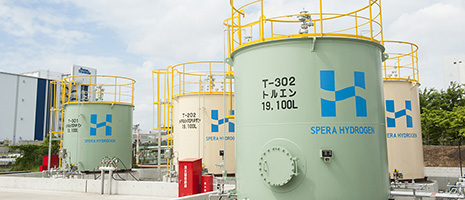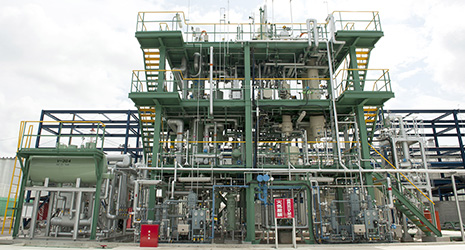Home > Highlighting JAPAN > Highlighting Japan March 2017 > Science & Technology
Highlighting JAPAN


Hopes Are High for New Technology for Hydrogen Storage and Transportation
Testing is under way of a new technology to safely store and transport large volumes of hydrogen in a secure liquid state.
Hydrogen is currently attracting global attention as an alternative energy source to fossil fuels such as coal, petroleum and natural gas. When hydrogen is used as a fuel cell, it has very high energy efficiency. As the fuel cell is actually used, it does not emit CO2, which is a cause of global warming.
Therefore, hydrogen is expected to play a major role in the future as a secondary energy source along with electricity, natural gas and fuel oil.
Hydrogen has already begun to be used in fuel cells for households and in fuel-cell vehicles (FCV). Hydrogen can also be used as fuel for large-scale power generation, but its gaseous state at ambient temperatures and pressures makes it difficult to handle. The challenges of storing hydrogen for a long period of time and transporting it over long distances are a bottleneck for practical use. To safely store and transport a large amount of hydrogen, Chiyoda Corporation, an integrated engineering company, has developed the SPERA Hydrogen® system (SPERA means “to hope” in Latin).
“In general, for storing and transporting hydrogen, the volume of hydrogen is compressed using high pressure or the hydrogen is liquefied at -253°C,” says an engineer at the Hydrogen Supply Chain Development Unit at Chiyoda Corporation. “However, in either method, because a special container and facilities are necessary, new infrastructure is required. On the other hand, the SPERA Hydrogen® system is maintained in a liquid state at ambient temperatures and pressures, and therefore can be both stored in existing tanks for a long period of time and transported by existing tankers and tank trucks.”
SPERA Hydrogen® is a liquid called methylcyclohexane (MCH) and is produced using the organic chemical hydride (OCH) method in which toluene, found in gasoline and gas oil, and hydrogen are catalytically reacted. The volume of MCH is about one to the 500th as low as that of hydrogen in a gaseous state.
The idea of the OCH method using MCH has been known since the 1980s and MCH is often used as a solvent for pen-type correction fluid. However, no commercial catalyst had been developed for producing hydrogen from MCH in the dehydrogenation process.
Chiyoda Corporation started development of the catalyst in 2002 and successfully developed a proprietary dehydrogenation catalyst that continuously delivers a stable high performance for more than 10,000 hours on a laboratory scale.
A variety of verification tests for commercial use has been conducted utilizing the demonstration plant at Chiyoda’s R&D Center in Yokohama. The satisfactory performance of the dehydrogenation catalyst has been assured in the demonstration operation, verifying its applicability to practical use.
In the future, if the mass transport of hydrogen energy is achieved by the SPERA Hydrogen® system, the environment surrounding energy would change drastically, not only in Japan, but all over the world. Hydrogen can be produced by reforming natural gas. If the hydrogen produced at oil and gas fields in resource-rich countries is transformed into SPERA Hydrogen® at a local hydrogenation plant, it can be exported to hydrogen-consuming countries including Japan in a large tanker, the same way we currently export crude oil. If countries that import hydrogen construct dehydrogenation plants as necessary, hydrogen can be efficiently utilized as an energy source for hydrogen power generation and hydrogen stations for FCVs. In addition, by producing hydrogen using surplus electricity from power generated by renewable energy sources such as wind power, solar power and hydroelectric power, and by transporting it as SPERA Hydrogen®, alternative clean energy not derived from fossil fuels can be supplied.
The New Energy and Industrial Technology Development Organization (NEDO) is currently promoting a business demonstration project for a hydrogen supply chain scheme using the SPERA Hydrogen® system. In addition, in the seaside industrial zone and the port facilities in Kawasaki City, the Kawasaki City government and Chiyoda Corporation are jointly promoting a construction scheme for a hydrogen supply network system using SPERA Hydrogen® as a field demonstration and verification project. Under the project, SPERA Hydrogen® generated as byproduct hydrogen is transported from overseas (southeast Asia) and dehydrogenated in Kawasaki. The project is scheduled to be put into practical use in 2020. In the stadiums and athletes’ village for the Olympic and Paralympic Games to be held in Tokyo in 2020, hydrogen might be produced from SPERA Hydrogen® which is also planned to supply electricity and to power a fuel cell (FC) bus for transporting athletes and spectators. The Tokyo Olympic and Paralympic Games will be an opportunity for people around the world to see the arrival of a society with full-scale use of hydrogen.
© 2009 Cabinet Office, Government of Japan






